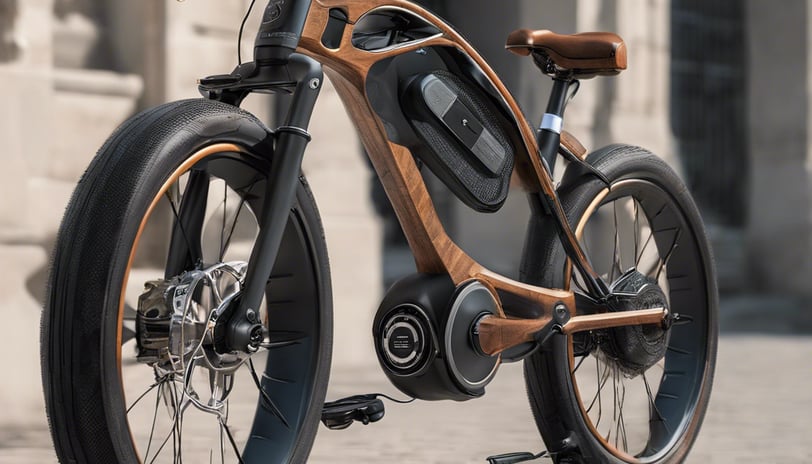Turn Every Ride Into an Adventure, Your Electric Freedom Awaits! 🚴♂️⚡ SHOP NOW! 🌍🚀
Electric E-Bikes vs. Traditional Bikes: Which is Better?
Sara p.
12/15/20237 min read


Introduction to Electric E-Bikes and Traditional Bikes
In recent years, the debate between electric e-bikes and traditional bikes has gained considerable attention among cycling enthusiasts and casual riders alike. To understand this discussion, it is crucial to first explore the basic concepts and functionalities of both electric e-bikes and traditional bikes. By doing so, we can better appreciate their unique attributes and performance characteristics.
Electric e-bikes, or electric bicycles, are similar to traditional bicycles but come equipped with electric components such as a motor, battery, and pedal-assist system. The motor is typically integrated into the bike's frame or wheel hub, providing additional power to assist riders, particularly on inclines or during long rides. The battery, another vital component, powers the motor and can usually be removed for charging. Pedal-assist systems detect the rider’s pedaling and deliver power accordingly, enhancing the riding experience by reducing the effort needed to pedal, making it easier to navigate challenging routes or commute over long distances.
On the other hand, traditional bikes have been around for much longer and come in various styles suited to different terrains and purposes. These include mountain bikes, designed for off-road cycling with features that handle rough terrain; road bikes, built for speed and efficiency on paved surfaces with lightweight frames and narrow tires; and hybrid bikes, which combine elements of both mountain and road bikes to offer versatility for diverse riding conditions. Traditional bikes rely solely on the rider’s physical effort to move, making them an excellent option for those seeking exercise, skill development, and the simplest mechanical structure.
By understanding the basic components and functions of electric e-bikes and traditional bikes, readers can better engage in an informed comparison of their advantages, limitations, and suitability for varied cycling needs and preferences. This foundational knowledge sets the stage for a deeper discussion of which type of bike might be the better choice for different riders.
Performance and Speed: A Comparative Analysis
When discussing performance and speed, it's essential to evaluate how electric e-bikes and traditional bikes operate under different conditions. Electric e-bikes, equipped with motorized assistance, offer a significant advantage in terms of speed and ease of riding. This assistance is particularly beneficial on uphill terrains and during long-distance travels. The electric motor provides a consistent level of support, helping riders maintain speed with less physical effort. Consequently, electric e-bikes can reach higher speeds more comfortably compared to their traditional counterparts.
Traditional bikes, which rely solely on human power, necessitate greater physical exertion to achieve and maintain speed, especially on challenging terrains. The rider's stamina and strength directly influence the bike's performance, often resulting in variable speeds. While traditional bikes are lightweight and require no battery charging, they demand more from the rider, which can be a limiting factor during long-distance voyages or steep inclines.
The key advantage of e-bikes lies in their ability to offer a more consistent and less physically demanding ride. This feature makes electric e-bikes an appealing option for a broader range of users, including those who may not have the physical capability to ride a traditional bike over longer distances or challenging routes. The motorized assistance also allows for a more enjoyable and efficient commuting experience, reducing fatigue and enabling riders to tackle more extensive journeys.
In juxtaposition, traditional bikes foster a stronger physical workout, potentially benefiting those seeking to enhance their fitness levels. However, the increased effort required can be a deterrent for casual riders or those with health limitations. Overall, the integration of motorized assistance in electric e-bikes significantly enhances their performance, offering a more versatile and universally accessible mode of transport.
When comparing the physical fitness and health benefits of electric e-bikes and traditional bikes, it is essential to consider the different types of workouts each offers. Traditional bikes require sustained physical effort from the rider, which can lead to significant cardiovascular benefits. Riding a traditional bike involves continuous pedaling, engaging major muscle groups such as the quadriceps, hamstrings, glutes, and calves. This activity not only strengthens these muscles but also aids in improving endurance and overall cardiovascular health.
Moreover, riding a traditional bike is an effective way to burn calories. Depending upon intensity and duration, traditional biking can burn between 400 to 800 calories per hour, making it an efficient form of exercise for weight management and fat loss. The consistent effort required in traditional biking accelerates heart rate, contributing to enhanced lung capacity and improved circulation.
Conversely, electric e-bikes come equipped with a pedal-assist feature, which can be adjusted to offer varying levels of assistance. This feature allows riders to engage in physical activity without overexerting. While the electric motor aids in propulsion, users still need to pedal, which means muscle engagement and calorie burn are very much part of the experience. Research suggests that riding an electric e-bike can burn around 300 to 600 calories per hour, depending on the level of assistance selected. This aspect makes e-bikes an excellent option for individuals looking to gradually improve their fitness levels or those needing recovery from injury, as the adjustable assistance prevents excessive strain.
Cardiovascular benefits are also attainable with electric e-bikes, though they might be slightly lower compared to traditional biking due to the intermittent motor aid. However, this does not diminish the positive impact on heart health. Electric e-bikes offer the advantage of extended ride time without fatigue, promoting longer periods of moderate physical activity which is beneficial for heart health.
In summary, both electric e-bikes and traditional bikes provide substantial physical fitness and health benefits. Traditional bikes are optimal for those seeking vigorous exercise, substantial calorie burn, and muscle strengthening. Electric e-bikes, while still offering exercise benefits, are ideal for individuals aiming for moderate physical activity with less strain, making them suitable for a broader range of fitness levels and health goals.
Environmental Impact and Sustainability
The environmental impact and sustainability of electric e-bikes and traditional bikes are critical factors to consider when choosing between the two. Traditional bikes are often celebrated for their minimal environmental footprint. The production process is relatively simple and involves fewer materials, which results in lower overall carbon emissions. Moreover, traditional bikes do not rely on electricity or batteries, making their operational carbon footprint virtually zero.
In contrast, electric e-bikes, while still an eco-friendly alternative to automobile transportation, present a more complex environmental profile. The production of e-bikes involves manufacturing and assembling electric motors and lithium-ion batteries, which come with a higher carbon footprint. The mining of materials like lithium, cobalt, and nickel, essential for battery manufacturing, can have significant ecological consequences, including habitat destruction and water pollution.
Additionally, the disposal of these batteries poses a considerable environmental challenge. Improper disposal can lead to the release of toxic substances, although recycling programs are steadily being developed to mitigate this issue. Despite these concerns, e-bikes do offer substantial environmental benefits over cars or motorcycles by helping to reduce greenhouse gas emissions and urban air pollution.
From a sustainability viewpoint, both types of bikes support a reduction in reliance on fossil fuels. Traditional bikes enable people to travel efficiently without any direct emissions. Electric e-bikes, though not entirely emission-free, offer a significant reduction in CO₂ emissions compared to fuel-based transportation methods, especially for longer distances or for riders who may struggle with the physical requirements of traditional biking.
In summary, while traditional bikes have a clear edge regarding lower production and operational carbon footprints, e-bikes present a more environmentally advantageous alternative to motor vehicles. The choice between the two ultimately depends on individual priorities, such as convenience and capacity for physical exertion, balanced against environmental considerations. Both electric e-bikes and traditional bikes indisputably contribute to more sustainable urban mobility.
Cost Considerations and Maintenance
When contemplating the purchase of an electric e-bike versus a traditional bike, cost considerations and maintenance expenses play a pivotal role. Initially, electric e-bikes generally come with a higher price tag compared to traditional bicycles. This is largely attributed to the sophisticated electric components integrated into e-bikes, such as the motor and battery. On average, an entry-level electric e-bike can range from $1,000 to $3,000, whereas basic traditional bikes can be acquired for a few hundred dollars.
Beyond the initial purchase, ongoing maintenance expenses should also be scrutinized. Electric e-bikes require specialized care for their electric drive systems. For instance, battery replacement is a crucial aspect to consider; depending on usage, a new battery might be needed every 3 to 5 years, costing about $300 to $700. Additionally, e-bike owners must account for the cost of electricity required for charging the battery, which, although relatively low, is an ongoing expense. Regular software updates and occasional servicing from a professional who specializes in electric bikes may also be necessary, adding to the total cost of upkeep.
On the other hand, traditional bikes primarily incur maintenance costs due to regular wear and tear. Conventional bikes require periodic attention to components such as tires, chains, and brakes. The costs of these parts and routine services are generally lower compared to electric e-bike maintenance. For instance, new tires, chains, and brake pads usually total under $150 and can last for several months to a year, depending on the frequency of use. Additionally, traditional bikes do not have the complexity of electronic parts, making at-home maintenance more feasible for most cyclists.
Evaluating long-term expenses, electric e-bikes may present potential savings in scenarios where they replace car usage. The savings on fuel, parking fees, and car maintenance can offset the higher initial and maintenance costs of electric e-bikes. Conversely, traditional bikes, with their lower upfront and maintenance costs, offer a more immediate economic benefit. Careful evaluation of these financial aspects will help readers make an informed choice tailored to their needs and budget limitations.
Conclusion: What’s the Verdict?
In evaluating the merits of electric e-bikes versus traditional bikes, it becomes clear that each type offers distinct advantages, tailored to different needs and preferences. Electric e-bikes stand out for their ability to provide an assisted ride, making them an excellent choice for those looking for an easier commute, the ability to tackle challenging terrains effortlessly, or simply an option that encourages more frequent rides by reducing physical exertion. The integration of modern technology in electric bikes enhances convenience and broadens their appeal, particularly for urban dwellers and older adults who may otherwise find cycling too strenuous.
Conversely, traditional bikes remain highly valued for their simplicity, lower cost, and the potential for a more rigorous workout. They are particularly suitable for individuals who prioritize minimalism and are keen on maintaining fitness through cycling. Traditional bikes do not require charging and can be more easily maintained, making them a reliable choice for cyclists who value independence and cost-effectiveness. Moreover, for eco-conscious riders seeking the most environmentally friendly mode of transport, traditional bikes have the upper hand due to their zero reliance on electricity or batteries.
Ultimately, the decision between an electric e-bike and a traditional bike hinges on personal circumstances. Scenarios favoring electric e-bikes include long-distance commutes, hilly terrains, and users with physical limitations. Conversely, those looking for a straightforward, cost-effective, and fitness-oriented cycling experience might find traditional bikes more appealing. Readers are encouraged to assess their specific needs, lifestyle, and personal priorities in order to make an informed choice that aligns best with their individual requirements.
Whether you opt for the high-tech allure of an electric e-bike or the timeless appeal of a traditional bike, ensuring the choice enhances your cycling experience is most crucial. Evaluate your own needs comprehensively and embark on the path that suits you best.
Address:
999 Charlotte Hwy, NC 28730, USA
Sales:
Email: sales@ecobikemachines.com
Call: (863) 272-9235
Subscribe to our newsletter
COMPANY
Online Support:
Email: support@ecobikemachines.com
Call: (626) 686-4545
